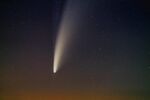Astronomy:TOI-561 b
| Discovery | |
|---|---|
| Discovered by | Transiting Exoplanet Survey Satellite |
| Discovery date | 2020 |
| Transit | |
| Orbital characteristics | |
| 0.0106 AU | |
| Orbital period | 0.4 d |
| Star | TOI-561 |
| Physical characteristics | |
| Mean radius | 1.425 R⊕ |
| Mass | 2 M⊕ |
TOI-561 b is an USP Super-Earth with a radius of roughly 1.4 Earths. It has an extremely short orbital period of under 11 hours, less than half of an Earth day, resulting in an equilibrium temperature of 2,480 ± 200 K (2,207 ± 200 °C; 4,004 ± 360 °F).[1] The planet is believed to be far too small and irradiated to hold onto its primordial Hydrogen and Helium envelope. However, the composition of the planet varies greatly between the two studies. Weiss 2020 found a mass of around 3.2 Earths and a density of 5.5 grams per cubic centimetre, around the same as Earth and implying a rocky but iron-poor composition.[1] Lacedelli 2020, on the other hand, found a mass of only 1.59 Earths and a density of 3.0 grams per cubic centimetre, abnormally low for a planet of its size and suggesting a composition made of 50% or more of water. Even their higher mass estimate of 1.83 Earths is consistent with a water world. With an insolation 5,100 times greater than Earth, TOI-561 b should have lost its gaseous layer and have little volatiles, so the authors believe if the planet has a significant amount of water, it has been evaporated into a puffy steam atmosphere that makes the planet seem larger, less dense, and more water-rich. If it is an extremely water-rich world, TOI-561 b would prove formation scenarios about Super-Earths forming beyond the "Snow Line" and migrating inwards.[2]
References
- ↑ 1.0 1.1 Weiss, Lauren M. et al. (2020). "The TESS-Keck Survey II: Masses of Three Sub-Neptunes Transiting the Galactic Thick-Disk Star TOI-561". The Astronomical Journal 161 (2). doi:10.3847/1538-3881/abd409. Bibcode: 2021AJ....161...56W.
- ↑ Lacedelli, G. et al. (2021). "An unusually low density ultra-short period super-Earth and three mini-Neptunes around the old star TOI-561". Monthly Notices of the Royal Astronomical Society 501 (3): 4148–4166. doi:10.1093/mnras/staa3728. Bibcode: 2021MNRAS.501.4148L.
 |




